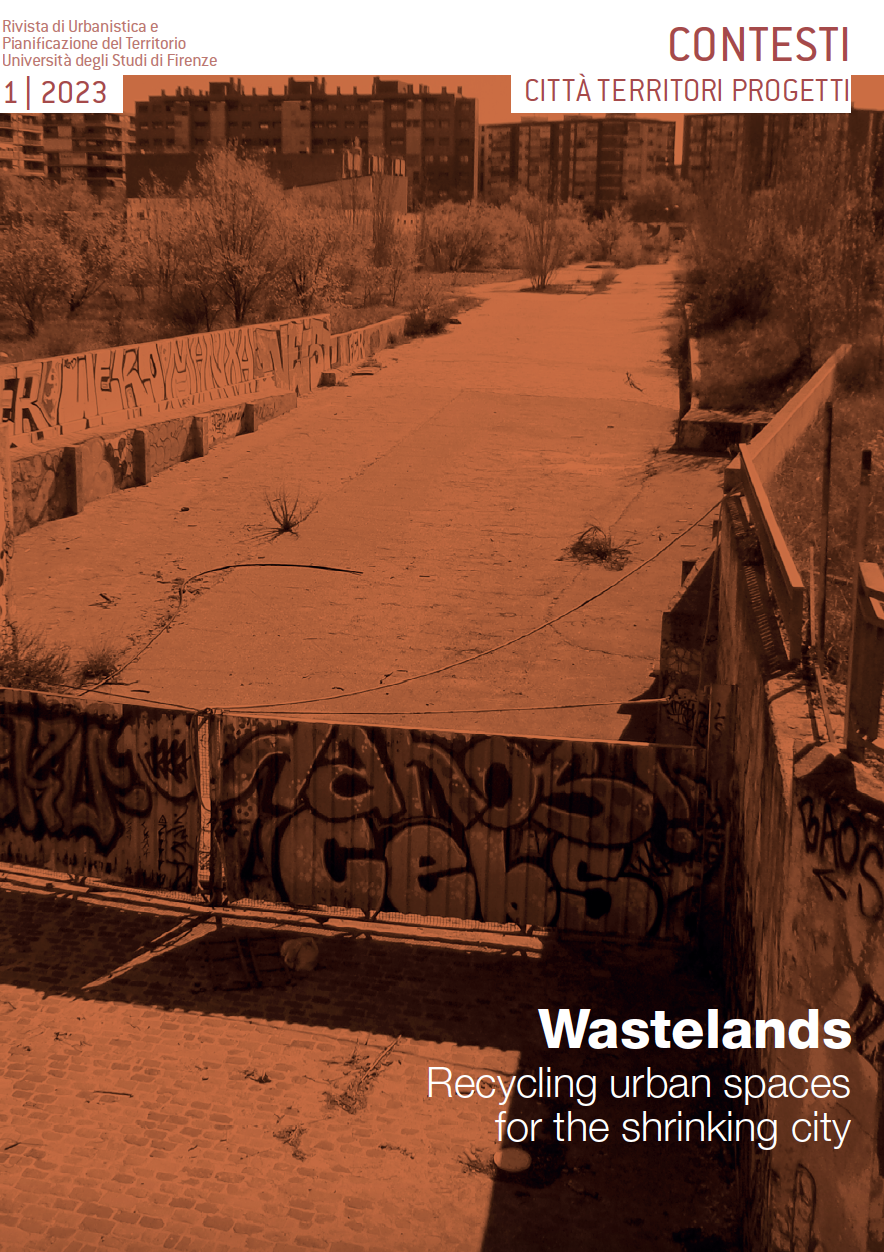Published 2023-09-12
Keywords
- Urban Regeneration,
- industrial wastelands,
- shrinking cities,
- de-industrialisation
How to Cite
Copyright (c) 2023 Ícaro Obeso Muñiz, Arturo Colina Vuelta

This work is licensed under a Creative Commons Attribution-NonCommercial 4.0 International License.
Abstract
This research focuses on the identification of industrial wastelands in Langreo and the strategies employed for their regeneration. The breakdown of the industrialisation production model, characterised by the
concentration of mining and iron and steel activities, introduced economic, social and landscape changes. For all these reasons, Langreo is a clear example of a shrinking city, as it presents the characteristic features that defi ne these cities, such as the loss of population, the cessation of productive activities, processes of environmental and landscape deterioration and urban transformations that are manifested by the presence of industrial wastelands and degraded spaces. The process of regeneration of these spaces is characterised by the lack of planning instruments, the absence of a comprehensive strategy for the whole area and its implementation is therefore the result of the individual initiative of each agent involved.
Downloads
References
- Alonso Iglesias, G., Marco Cosgaya, C., Rey Mahia, C., Rey Matilla, J., Vega Cadavieco, I., Calvo Buelga, L., Cebada Relea, A., Rodríguez Pereira, C., Rubio Revilla, J., Colina Vuelta, A., Rodríguez Valdés, E. y Rodríguez Gallego, J. L. (2019). Regeneración ambiental y nuevos usos de los baldíos industriales en el eje fluvial de Langreo. Naturalia Cantabricae, 7(1), 1-14. https://www.indurot.uniovi.es/c/document_library/get_file?uuid=dfb55bf5-b55c-45e1-a8cd-2ebb6034bc2d&groupId=2490442
- Benito del Pozo, P. (1990). El declinar de los espacios minero-siderúrgicos tradicionales: evolución reciente de Mieres y Langreo (Asturias). Ería: Revista cuatrimestral de geografía, (23), 235-252. https://doi.org/10.17811/er.0.1990.235-252
- Döringer, S., Uchiyama, Y., Penker, M., & Kohsaka, R. (2019). A meta-analysis of shrinking cities in Europe and Japan. Towards an integrative research agenda. European Planning Studies, 28, 1693 - 1712. https://doi.org/10.1080/09654313.2019.1604635
- Fernández Agueda, B. y Cunningham-Sabot, E. (2018). Del declive al decrecimiento urbano: un debate en construcción. Anales de Geografia de la Universidad Complutense, 38(2), 341-356. https://doi.org/10.5209/AGUC.62483
- Fernández García, A. (1980). Langreo: industria, población y desarrollo urbano. Universidad de Oviedo. http://hdl.handle.net/10651/22651
- Fernández García, A. (1982). Las ciudades mineras: Langreo y Mieres. En Geografía de Asturias (pp. 15-133). Ayalga.
- Fernández García, A. (1996). La calidad ambiental como premisa del desarrollo urbano. Propuestas y actuaciones en la Cuenca del Nalón (Asturias). Ería: Revista cuatrimestral de Geografía (41), 249-257. https://doi.org/10.17811/er.0.1996.249-257
- Fernández García, A. (1997). La nueva política estatal de desarrollo regional y sus efectos en Asturias (1895-1995). Ería: Revista cuatrimestral de Geografía (43), 238-242. https://doi.org/10.17811/er.0.1997.238-242
- Cauce del Nalón. (15 de marzo de 2022). Resiliencia en espacios desindustrializados [Archivo de Vídeo]. Youtube. https://www.youtube.com/watch?v=_GmIGpjYkGE
- Häußermann, H., & Siebel, W. (1988). Die schrumpfende Stadt und die Stadtsoziologie. Soziologische stadtforschung, 78-94. https://doi.org/10.1007/978-3-322-83617-5_5
- Haase, D. (2008). Urban ecology of shrinking cities: An unrecognized opportunity? Nature and Culture, 3(1), 1-8. https://doi.org/10.3167/nc.2008.030101
- Escudero-Gómez, L. A., García-González, J. A., & Martínez-Navarro, J. M. (2023). What is happening in shrinking medium-sized cities? A correlational analysis and a multiple linear regression model on the case of Spain. Cities, 134, 104205. https://doi.org/10.1016/j.cities.2023.104205
- Gatzweiler, H.-P., K. Meyer und A. Milbert 2003: Schrumpfende Städte in Deutschland? Fakten und Trends. – Informationen zur Raumentwicklung 10/ 11. – Bonn: 557-574
- Lampen, A., & Owzar, A. (Eds.). (2008). Schrumpfende Städte: ein Phänomen zwischen Antike und Moderne (Vol. 76). Böhlau Verlag Köln Weimar.
- Lima, M. F. y Eischeid, M. R. (2017). Shrinking cities: rethinking landscape in depopulating urban contexts. Landscape Research, 42(7), 691-698. https://doi.org/10.1080/01426397.2017.1372167
- Maurín Álvarez, M. (1987). Introducción al estudio geográfico de las cuencas mineras españolas. Ería: Revista cuatrimestral de geografía, (12), 5-24. https://doi.org/10.17811/er.0.1987.5-24
- Nathanail, P., Thornton, G., & Millar, K. (2003). What’s in a Word: UK and international definitions of ‘brownfield’. Chapter, 4, 43-45.
- Prada Trigo, J. (2011). Desarrollo, patrimonio y políticas de revitalización en ciudades intermedias de especialización minero-industrial. El caso de Langreo (Asturias). Consejo Económico y Social del Principado de Asturias. http://ria.asturias.es/RIA/handle/123456789/4021
- Rodríguez Gallego, J.L. (2019). Propuestas para la regeneración de baldíos industriales y espacios degradados en el municipio de Langreo. INDUROT. Universidad de Oviedo.
- Rodríguez Gutiérrez, F., y Menéndez Fernández, R. (2003). La comarca del Nalón en su contexto metropolitano. La Ciudad Lineal del Nalón en Ciudad Astur. Ería: Revista cuatrimestral de Geografía, (60), 55-87. https://doi.org/10.17811/er.0.2003.55-87
- Sánchez-Moral, S., Méndez, R. y Prada Trigo, J. (2012). El fenómeno de las “shrinking cities”: una aproximación a las causas, efectos y estrategias de revitalización a través del caso de estudio de Avilés. En Nuevos Aures en la Geografía Española: Contribución Española al 32o Congreso Internacional de Geografía. Colonia 2012 (pp. 252-266). Comité Español de la UGI.
- Tomé Fernández, S. (2010). Langreo, Mieres, Ponferrada, Puertollano: cambios funcionales y morfológicos en ciudades minero industriales. Scripta Nova: Revista electrónica de geografía y ciencias sociales. https://revistes.ub.edu/index.php/ScriptaNova/article/view/1641
- Vaquero, J.M. (2 de diciembre de 1979). Langreo, el municipio más contaminado de España. El País. https://elpais.com/diario/1979/12/02/espana/312937213_850215.html
- Wiechmann, T. y Bontje, M. (2015). Responding to Tough Times: Policy and Planning Strategies in Shrinking Cities. European Planning Studies, 23(1), 1-11. https://doi.org/10.1080/09654313.2013.820077
- Wolff, M., & Wiechmann, T. (2018). Urban growth and decline: Europe’s shrinking cities in a comparative perspective 1990–2010. European Urban and Regional Studies, 25, 122 - 139. https://doi.org/10.1177/0969776417694680

